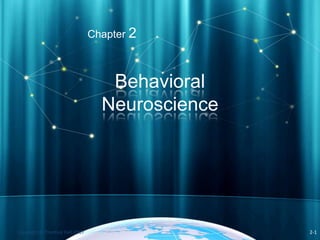
Psychology, Chapter 2, Behavioral Neuroscience
- 1. Behavioral Neuroscience Chapter 2 Copyright © Prentice Hall 2007 2-1
- 2. Behavioral Neuroscience • Why study this in psychology? • How can it help us understand the goals of psychology? • Goals – Describe – Understand – Predict – Control or modify • Behaviors & thoughts
- 3. Biology and Behavior • Behavioral neuroscience –Studies • Relation between biological & psychological functions –Can help us understand • Nature of personality • Causes of abnormal behavior • Reaction to stress • Effectiveness of therapy Copyright © Prentice Hall 2007 2-3
- 4. Historical View of the Brain • 1000 BC Egyptian Pharaohs mummification • Brain – Removed & discarded • Vital to afterlife – Heart • Left in body • Seen as containing perception, cognition & soul – Intestines, liver, lungs & stomach • Removed, wrapped & placed in canopic jars.
- 5. Historical View of the Brain • Many cultures similar views of heart • Brain interpreted in various ways – Aristotle cooling emotions of heart • Change began in 1500’s • Leonardo da Vinci 1452-1519 – Head seen as holding cognition – Ventricle system • Holes in the brain.
- 6. Ventricular System • Cavities or holes in brain holding cerebrospinal fluid
- 7. Mrs. Garrison’s Theory of Evolution
- 8. Evolutionary Psychology • Focuses on –Adapted benefits of selected behaviors • Women –Talk –Multi-task » Women larger area for communication • Men –Quiet –Singularly focused » Larger area of brain for sex
- 9. • Why doesn’t an organism ever achieve perfect adaption? Evolutionary Psychology
- 10. • Why doesn’t an organism ever achieve perfect adaption? –Each adaption has: • Costs? • Benefits? –Increased head size? Evolutionary Psychology
- 11. Evolution Does : • Works to improve reproduction success Evolution Doesn’t: • Work to improve a species • Have a conscious plan or purpose • Work to produce happiness or contentment Evolution
- 12. Evolutionary Psychology – Natural selection • Evolutionary process by which those individuals of a species that are best adapted are the ones that survive & reproduce – Survivors better adapted to world than non- survivors
- 13. Evolutionary Psychology Emphasizes importance of Adaptation Reproduction “Survival of the fittest” In shaping behavior Spatial skills in finding way home Fit Ability to Bare offspring that survive long enough to bare offspring Pass your genes to next generation
- 14. Biology and Behavior • Scientists who study this: –Represent several disciplines • Psychology (especially physiological psychologists) • Biology • Medicine • Others Copyright © Prentice Hall 2007 2-14
- 15. Neurons • Neurons –Cells that transmit information • Neurons are composed of: –Dendrites –Soma • Cell Body –Axon
- 16. Myelin Sheath • Myelin Sheath – Composed of glial cells • (Greek word for “glue”) – Coats axon of some neurons – White matter of brain – Functions: • Speeds neurotransmission • Insulates neurons from each other • Makes neurotransmission more efficient • Removes waste • Occupies vacant space when neurons die • Other purposes Copyright © Prentice Hall 2007 2-16
- 17. Copyright © Prentice Hall 2007 2-17 • Myelin –Looks like string of sausages –Doesn’t cover entire length of axon –Nodes of Ranvier • Space between “sausages” • Nerve impulse jumps from 1 node of Ranvier to next • Transmission up to 100 x’s faster –Unmeylinated axons
- 18. Terminal Button 1. Synthesis of neurotransmitter (NT) 2. Storage & transport of NT within vesicles 3. NT Release 4. Activation of postsynaptic receptors 5. Termination of transmitter effect (e.g. reuptake)
- 19. Neurotransmitters • Dopamine – Controls arousal levels – Significant role in motor movement – Reward & punishment • Serotonin – Role in • Weight regulation • Sleep • Depression • Suicide • obsessive–compulsive disorder • Aggression • Wide range of other disorders & behavior problems. Copyright © Prentice Hall 2007 2-19
- 20. • Acetylcholine – Attention – Learning – Memory • Norepinephrine –Also a hormone –Physical & mental arousal –Heightens mood Copyright © Prentice Hall 2007 2-20 Neurotransmitters
- 21. Synapse • Synapse –Space between axon terminal & adjacent dendrite or cell body • Neurotransmitter (NT) –Molecules released from terminal button into synapse.
- 22. Neurons: Basic Cells of the Nervous System • Synapses – Cleared rapidly • So additional signals can be transmitted • Cleared in 1 of 2 ways, depending on neurotransmitter – 1. breakdown • Broken down & removed – 2. Reuptake • Recycled back into vesicles Copyright © Prentice Hall 2007 2-22
- 23. • SSRIs block reuptake of serotonin • Called selective – Primarily affect serotonin • Changes balance of serotonin SSRI Reuptake Inhibitor
- 24. SSRI Reuptake Inhibitor • Generic names followed by brand names –Citalopram (Celexa) –Escitalopram (Lexapro) –Fluoxetine (Prozac, Prozac Weekly, Sarafem) –Paroxetine (Paxil, Paxil CR, Pexeva) –Sertraline (Zoloft) –Fluoxetine combined with the atypical antipsychotic olanzapine (Symbyax)
- 25. Psychoactive Drugs • Drugs work in synapse • Agonists enhance neurotransmitter function • Antagonists block neurotransmitter function
- 26. Psychoactive Drugs • Psychoactive drugs –Affect nervous system • Alter mood • Emotion • Thought – Act by: • Increasing or decreasing release of neurotransmitters • Stimulating or blocking receptor sites
- 27. Opiates binding to opiate receptors • Increased dopamine release